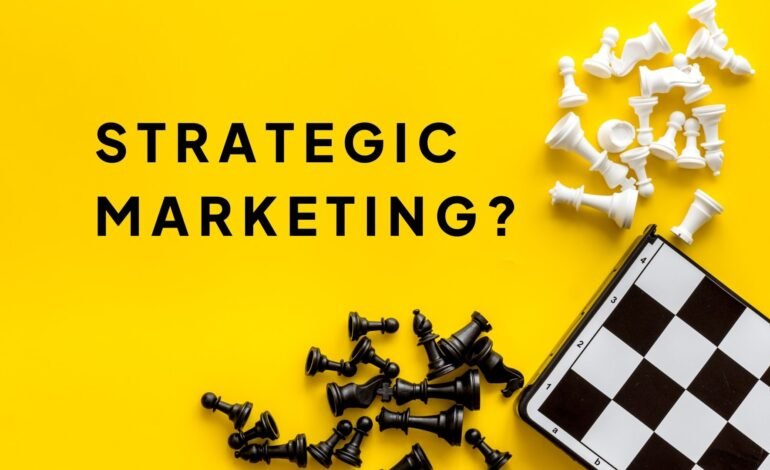Strategic marketing: definition, benefits and examples

We call “strategic marketing” the aspect of marketing focused on the medium and long term, which uses different market analysis techniques to detect opportunities that allow the company to grow and stand out in front of its consumers, always keeping in mind the needs of the user.
Instead of manufacturing products and services and then thinking about how to sell them to users, strategic marketing first analyzes the situation of the market, the competition, and consumers, and elaborates products and services based on the identified niches.
In contrast to this concept, we have operational marketing, which focuses on the short term and seeks to put into action the strategies we have previously defined. Within operational marketing, we would have the preparation of budgets and work at a tactical level on the different marketing actions. Within these actions we can find, for example, SEM campaigns and advertising on social networks, contests and raffles, promotions, communication of product launches, and a long etcetera.
It is important to be clear that both variants, strategic and operational, are necessary for success. It is not advisable to launch actions without a strategy behind them, but planning is also of no use to us if we do not take it into action.
To make your job easier, when putting your strategic marketing plan into action, I recommend that you download: “Checklist: list of prerequisites to launch your digital marketing campaigns“.
The steps to develop a strategic marketing plan
Since it is a vision of the future, strategic marketing is characterized by drawing up the company’s marketing plan. To do this, it will be necessary to carry out a series of preliminary steps:
- Market study. Before launching products and services on the market, it is necessary to take into account the panorama we are facing. What is the situation like for the economy in general and our sector in particular? Are there already other similar or complementary products? What unmet needs can we detect?
- Definition and segmentation of the target audience. Here, we will stop to develop the ideal buyer persona or customer of our services, taking into account their needs, challenges, and psychodemographic characteristics. We will also study whether we can distinguish between different subtypes that need to be segmented separately. The goal is to end up with a clear idea of who we want to target in order to segment our campaigns properly.
- Study of the competition. The study of the competition is still another factor in the study of the market, but it is advisable to delve into it because it can provide us with a lot of valuable information. At the very least, we need to research the most important companies that are direct competitors and find out what their product catalog, positioning, price, and strategies are. The ultimate goal will be to know how we can distinguish ourselves from them and improve their offer.
- Definition of the strategy. Once we have all this information on the table, we can choose between different strategies that allow the company to achieve its objectives (don’t miss the examples at the end of this article!).
Benefits of strategic marketing
- Know where we are. Strategic marketing allows us to get an overview of the market, the competition, and our potential customers. If we start from there, our actions will be much more likely to succeed than if we shoot blindly.
- To know the consumer better. In today’s marketing, consumers are always at the center. We have increasingly demanding and informed users, so it will be necessary to know their needs and preferences in depth and take them into account in each step of our marketing.
- Set clear goals. Strategic marketing provides solid research into the situation. From there, it will be much easier to see what it is that we want and how we can quantify it into a series of achievable goals.
- Distinguish our brand from the competition. If we do not carry out a good analysis of the situation, we run the risk of ending up selling products that are very similar to the competition and that do not represent an advantage for consumers. Thanks to previous analyses, we can know exactly what the gaps in the market are to hit the bullseye.
- Identify opportunities. If we are aware of the characteristics and trends of the market, we will be able to quickly detect opportunities that allow us to grow and reach new markets.
- Guide operational actions. Strategic marketing is like the compass that guides our campaigns. Without it, we are likely to end up lost and not knowing which direction to take. On the other hand, if we have defined the strategy correctly, we will always have a guide to make better decisions.
- Have a crisis plan. Last but not least, the development of a good marketing plan allows you to be prepared for all kinds of contingencies and act effectively in them.
Examples of Marketing Strategies
Within strategic marketing, we can find a multitude of strategies. Some of them are suitable for different phases of a product or a company’s life, while others may be complementary. These examples will help you find your way around:
- Product portfolio strategy. Here we seek to define and launch the most suitable products, taking into account the potential profitability and characteristics of each market. In addition to creating new products from scratch, it is also possible to enhance existing ones through quality variations, new models, or features etc.
- Positioning strategy. Each product occupies a certain place or category in the consumer’s mind, for example, “the detergent that washes the whitest” or “the cheap bike to get around the city”. In this section of our strategic marketing, we will look for the positioning that best suits us and how to achieve it.
- Functional or 4P strategy. It seeks to define and land the famous “4Ps of marketing“: product, price, promotion, and distribution. All of them must be translated into concrete actions and be coherent with each other.
- Growth strategy. Aimed at looking for ways to expand the company that make sense and are sustainable for the future, whether by including new products in the portfolio, opening up to other target audiences and markets, internationalizing the brand, or any other option. Within these paths, we can distinguish, for example, penetration strategies (increasing the company’s share in the markets it is targeting), market development (selling products in new markets), or diversification (expanding the number of products available, related to each other or even from other sectors).
- Loyalty strategy. This strategy seeks to consolidate the company in the long term by making existing customers regulars. It is a fundamental ingredient of many marketing plans, since it is much more profitable to retain existing customers than to be constantly looking for new ones.
Putting all this into practice, we can see examples of brands such as Toyota, which detected that there was a segment of the population that was increasingly concerned about the environment and responded to this need by bringing its Prius model to the market, a hybrid that uses both electricity and gasoline. Another example of responding to detected needs would be the multiple brands of electronic cigarettes (“vaping”) that appeared in Spain after the approval of the anti-smoking law. We can also see brands that at one point have chosen to open up to new international markets or even change their slogan and positioning.










